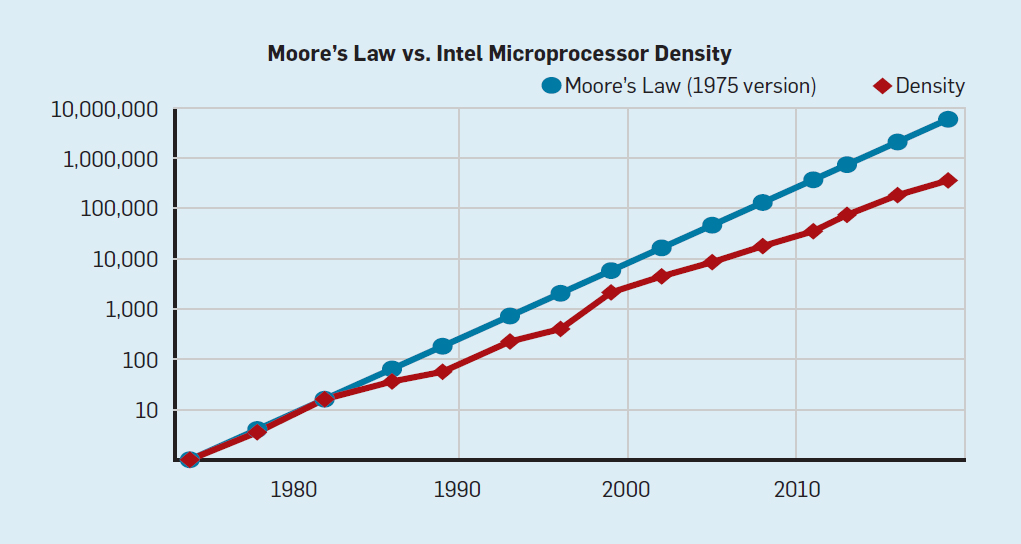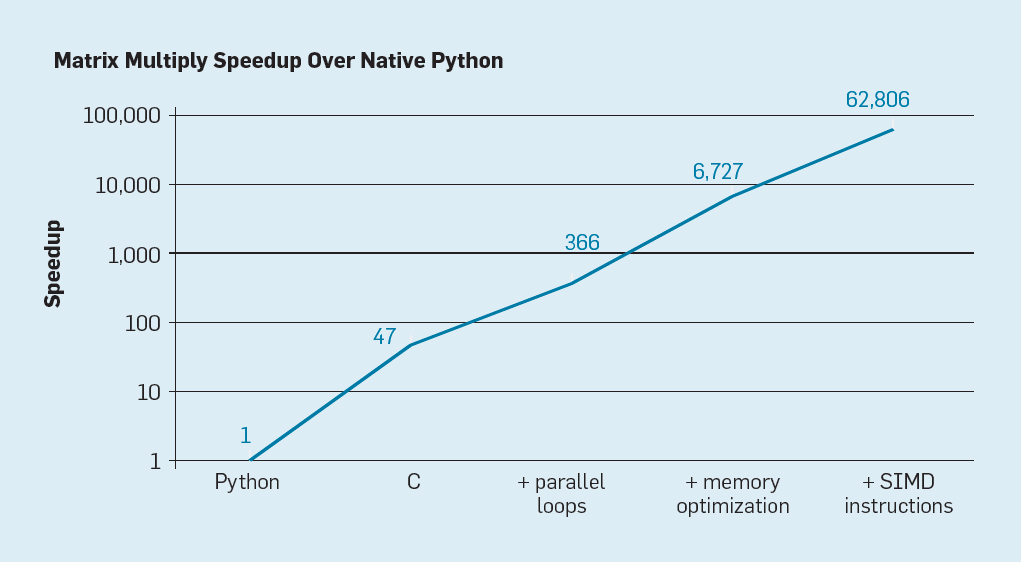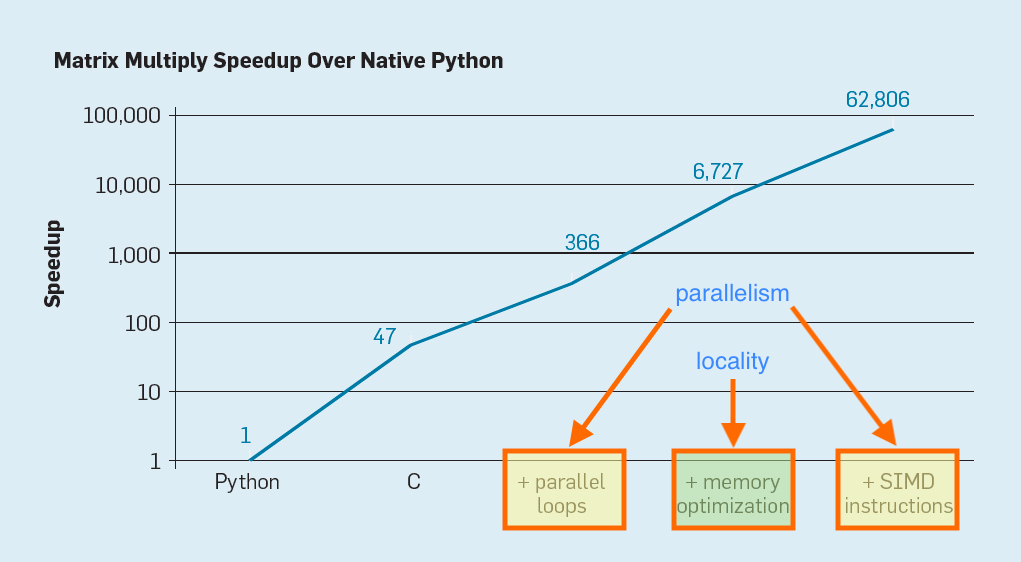Lecture 01: Intro and Motivation
COSC 272: Parallel and Distributed Computing
Spring 2023
Outline
- Course Motivation
- Structure and Policies
- Parallelism and Concurrency
Question
How do we quantify the computational power of a computer?
- How much more powerful are computers today than 5/10/25/50 years ago?
Speed = Power?
Tangible notion computational power:
- run a program and see how long it takes
- less time = faster execution = more (evident) power
Processor Speed = Power?
My first laptop:
- Compaq Presario 2100
- Intel Celeron processor @1.6 GHz
- $ 900 new (1,500 now w/ inflation)
- now < $ 15 used
My current laptop:
- Apple MacBook Pro, 2020
- Intel Core i5 @1.4 GHz
- $ 1,400 new (1,500 now w/ inflation)
- now ~ $ 600-1,000 used
Question. What gives?!
Moore’s Law
Transister density chip doubles every 2 years

Transister density for Intel chips (img source).
But Processor Speed Is Not Increasing!
| Year |
Transistors |
Clock speed |
CPU model |
| 1979 |
30 k |
5 MHz |
8088 |
| 1985 |
300 k |
20 MHz |
386 |
| 1989 |
1 M |
20 MHz |
486 |
| 1995 |
6 M |
200 MHz |
Pentium Pro |
| 2000 |
40 M |
2 000 MHz |
Pentium 4 |
| 2005 |
100 M |
3 000 MHz |
2-core Pentium D |
| 2008 |
700 M |
3 000 MHz |
8-core Nehalem |
| 2014 |
6 B |
2 000 MHz |
18-core Haswell |
| 2017 |
20 B |
3 000 MHz |
32-core AMD Epyc |
| 2019 |
40 B |
3 000 MHz |
64-core AMD Rome |
Speed vs Throughput
Processor speed = # processor clock cycles per second
-
latency of a single operation bounded by processor speed
- phyiscal constraints (e.g., speed of light) limit processor speed
Throughput = # useful operations processor can perform per second
Question. How can we increase throughput without increasing speed?
What is Parallelism?
The ability to perform multiple operations simultaneously.
Examples:
- bit-level parallelism (e.g., adding two 32-bit numbers)
- single instruction, multiple data (SIMD) parallelism
- multi-core: independent processors operating at same time on same computer
- distributed networks: clusters, server farms, internet
Promise of Parallelism
“Many hands make light work.”
- More processors \(\implies\) more operations per second!
- Greater throughput!
- Perform multiple operations at once!
The Power of Parallelism I

The Power of Parallelism II

Perils of Parallelism
More processors, more problems
- Some computations need to be done sequentially in order
- next step relies on result of current step
- Processors must share resources
- communication and sychronization are costly
- Nondeterminism
- different executions give different behavior
- algorithms must account for all possible executions!
Unavoidability of Parallel & Distributed Computing
Modern computing is inherently distributed!
- Different parts of the computer interact
- cores within processors
- processor registers, cache, main memory, IO, etc.
- Different computers interact
- local computer networks
- clusters and server farms
- internet
What this Course is About
-
Exploiting parallelism to write performant code
- write programs that are 100s of times faster than simple sequential code
-
Reasoning about parallel programs and executions
- parallel programs can be incredibly subtle!
- arguing correctness is significantly more challenging than for sequential programs
Expected Background (Programming)
- Object Oriented design in Java
- classes and inheritance
- interfaces
- exception handling
- generics
Expected Background (Conceptual)
- Basic data structures:
- linked lists
- stacks
- queues
- (balanced) trees
- Supported operations, and their complexities
Main Topics Covered
- multithreaded programming in Java
- mutual exclusion,
- concurrent objects,
- locks and contention resolution,
- blocking synchronization,
- concurrent data structures,
- SIMD/vector operations
Course Materials
-
The Art of Multiprocessor Programming (Moodle -> Course Reserves)
- Notes (posted to course website)
- Recorded lectures
Course Focus
-
Principles of parallel computing:
- conceptual & technical issues that are fundamental to parallel programming
- indpendent of computing technology
- want provable guarantees for behavior
- We care about performance but…
- newest technologies will not be emphasized
- prefer methods that enhance our understanding of a problem
Course Structure
- 3 lectures/week
- guided discussion
- small group discussion
- mixture of lecture/discussion/activities
- small-group activities will require your laptop
- Readings posted to course website
Coursework
- Coding Assignments (bi-weekly)
- some individual, some pairs
- focus on performance
- semi-competitive
- Written Assignments (bi-weekly)
- focus on formal reasoning/problem solving
- small groups
- Quizzes/in class activities
- Final Project (small group)
Attendance & Illness
Attendance
- Regular attendance is expected
- No penalty for a few missed classes
- lectures will be recorded and posted to Moodle
Illness & Masking
- do not attend class if you are sick (e.g., with fever)
- if mild symptoms:
- take a Covid test before coming to class
- wear a mask
- otherwise come to class, masks optional
Office Hours
Will’s office: SCCE C216
Drop-in (in person):
- M/W/F After Class (11:00–11:30)
By appointment (in person or on Zoom):
please wear a mask to in-person office hours
This Week
- Writing multithreaded programs in Java
- Subtleties of multithreading
What is Multithreading?
Preliminary question. What is a program?
- A sequence of operations to be performed
-
some operations may depend out the outcomes of other operations, others may be independent:
a1 = b1 + c1;
a2 = b2 + c2;
p = a1 * a2
A thread is a sequence of operations—think subprogram
- different threads specify logically independent sequences operations
Art of Multithreading
Goal. Partition a program into multiple (logically indpendent) threads.
Payoff. Different threads can be executed in parallel (on parallel computer architecture)
- computer with $k$ cores could see up to a $k$-fold increase in throughput!
Challenges.
- How to partition a program into threads?
- How to synchronize resources that must be shared by threads? (e.g., memory)
- How to ensure program always gives desired output?
- OS ultimately decides how to allocate resources…


